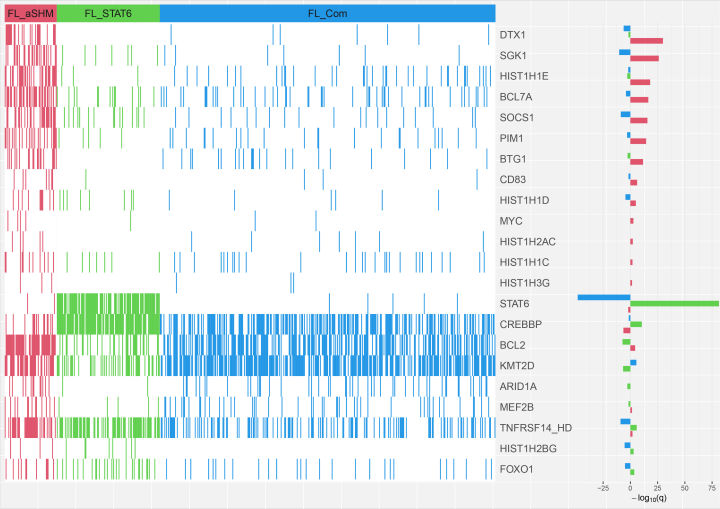DNA sequencing leads to new discovery
We looked at the patterns of genetic mutation in the tumour samples from a large group of patients with follicular lymphoma (FL), and were able to discern three new subclusters.

This research used samples of tumour tissue from people with follicular lymphoma (FL) and had them analysed by a lab to reveal their genetic structure. By looking at the patterns of genetic mutation in the tumour samples from a large group of patients, we were able to discern three new lymphoma subclusters. This new information can help us in a number of ways:
- It aids research into the mechanisms underlying this complex blood cancer
- this is important because the more we understand about what is happening, the more we can try to understand why it happens and prevent it.
- It will hopefully help us to personalise treatments for patients with this type of cancer in the future
- if the treatment is as specific as possible there is more chance of success and also of limiting collateral damage to the body from the treatment.
- Looking at the data revealed that although the three subclusters were different to each other there was no evidence of a difference in outcome for the patients
- none of them was worse than the others.
Background
Lymphoma is a type of blood cancer that develops when white blood cells called lymphocytes grow out of control. Lymphocytes are part of your immune system.
Follicular lymphoma (FL) is a common subtype of non-Hodgkin lymphoma. It develops slowly from the type of lymphocytes called B cells. It is called ‘follicular’ lymphoma because the abnormal B cells usually develop in clumps called ‘follicles’ inside lymph nodes. Currently, it cannot be cured and is typically managed through monitoring and periodic treatment to control the disease.
The database
The Haematological Malignancy Research Network (HMRN) provides information about leukaemias, lymphomas, myelomas, and related blood disorders. HMRN is a collaborative venture between researchers at the University of York and NHS clinicians working across 14 hospitals. It comprises all patients diagnosed with a blood cancer, or a related precursor condition, within a study region of approximately 4 million people.
What we did
We started with samples from 878 people who had been diagnosed with FL between September 2004 and August 2012. We excluded some samples for various reasons and ended up with 548 samples to sequence.
The samples were sent to the internationally renowned Sanger Institute to have their DNA sequenced. Looking at the patterns of mutations in the tumour DNA enabled us to group similar mutations together and to discern the three new subclusters of FL.
The 3 new subclusters
The image below shows the pattern of genetic mutations in the 3 different subclusters of FL that we identified in this research:

The abbreviations on the image are the names of the genes involved in each subcluster. The coloured bars on the right of the names show how frequent the mutations of that gene are in each cluster, relative to the cohort as a whole. Positive numbers indicate that mutations are more common than the average, and negative numbers indicate less common. In this way they show the mutational signature of each subcluster. For example:
- the FL subcluster FL_STAT6 (green) shows high levels of mutation in the genes called STAT6 and CREBBP.
- The subcluster FL_Com (blue) shows fewer mutations in most of the genes compared to the other two subgroups, but does have a positive profile for mutations in the KMT2D gene.
- The final subcluster FL_aSHM (red) is associated with a failure in the mechanism by which the body’s immune system adapts to new pathogens.
Interestingly all three subclusters have a similar outcome for the patient.
What this means
Professor Reuben Tooze, senior author of the research, says:
"We show that follicular lymphoma, one of the commonest immune system cancers, resolves into three types based on patterns of genetic mutation characterised by:
Contact us
Helen Cohen
ECSG Research Administrator
helen.cohen@york.ac.uk
+44 (0)1904 32 1927
Seebohm Rowntree Building,
University of York,
UK,
YO10 5DD
Twitter
Related links
Read the full research article here:
Molecular subclusters of follicular lymphoma
A report from the UK's HMRN
Some parts of cells mutate a lot (hyper) on purpose so that they can create lots of different antibodies in order to protect us from the many and various pathogens we encounter. However, this can sometimes malfunction (become deregulated) and the wrong elements or cells are mutated. If this happens too much, it can lead to a cell becoming cancerous.
The normal signals that tell our cells what is happening around them and how to behave in order to keep our body running smoothly, can become damaged or mutated and end up not working properly (deregulation). This can cause the body’s defences to malfunction, or even to multiply to the point where they become a problem, and potentially even a cancer themselves.
These are molecules that help control how much or how little a gene is used by a cell (regulators). If the genes that produce these regulators become mutated, then the regulators can’t do their job properly, causing problems in the cell. If they affect the function of the cell enough then this can become cancer.
Together these results provide a molecular basis for developing new approaches to treatment focusing on disease mechanism."
Read the full research article
Further reading
This technique has previously been successful with identifying subtypes of diffuse large B-cell lymphoma (DLBCL) - Read the DLBCL research here
Contact us
Helen Cohen
ECSG Research Administrator
helen.cohen@york.ac.uk
+44 (0)1904 32 1927
Seebohm Rowntree Building,
University of York,
UK,
YO10 5DD
Twitter
Related links
Read the full research article here:
Molecular subclusters of follicular lymphoma
A report from the UK's HMRN